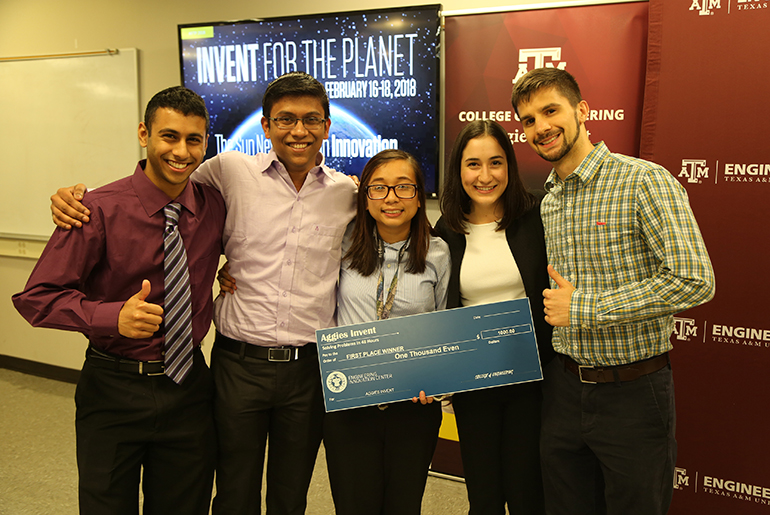
With 48 hours on the clock, students from 14 universities set out to make an impact on the world this past weekend. In the end, more than 400 students in 10 different countries came up with solutions to problems facing the globe. Spearheaded by Texas A&M University’s Engineering Entrepreneurship Program, Invent for the Planet followed the format of Aggies Invent, an intensive design challenge that gives students hands-on experience with solving problems in 48 hours.
The event kicked off at 4 p.m. local time Friday, Feb. 16 in Cambodia (3 a.m. CDT). As the Earth continued to rotate, more universities joined the challenge. From Myanmar to Idaho, collaboration was key as students raced to develop solutions to 15 need statements sourced by some of the participating universities as well as USAID. Each student had access to Microsoft Teams software, which allowed students to easily communicate with one another via messages, video chat or audio calls.
The winners
Each university named a first, second and third place winning team. At Texas A&M, the first place team, Illuminate, designed a lighting solution for children in developing countries without access to electricity to be able to study after dark. The second place team, Erase the Waste, created an affordable bag that could be used to keep grains such as rice from going bad or being exposed to insects. The third place team, Samara, developed a device that could safely transport medication to rural areas.
The first-place winners from each team will compete against each other to be named the overall Invent for the Planet winner on Monday, Feb. 26. The grand prize includes an invitation for up to six members of the winning team to come to Texas A&M in March to continue their work with experts. The winning team will also present their project at the VentureWell OPEN Minds Showcase and Reception March 24 at the Bullock Texas State History Museum in Austin, Texas, and will have a chance to win up to $3,000.
A global collaborative experience
“It was incredible watching all 14 universities around the world working on solutions to some of the planet’s biggest challenges,” said Rodney Boehm, director of Engineering Entrepreneurship at Texas A&M. “From food security and waste management to the environment and education — the ideas these students came up with were innovative and groundbreaking. I can’t wait to see some of these ideas come to fruition.”
One such idea is already being implemented at State University of Pernambuco in Recife, Brazil. The School of Engineering is taking their winning team’s design — a system that keeps track of energy consumption in a household or business — and will be using this system in all 10 engineering buildings on campus in an effort to reduce their expensive energy bill.
In the end, Boehm said that’s what it’s all about — “turning ideas into reality and making a difference in the world.”
“For some of my students, this opportunity was the first time they have been exposed to other universities abroad, so I was more than happy,” Dr. Fernando Buarque, in Brazil, said. It was the first time his university has ever hosted an intensive design experience challenge.
It was a first for Mahidol University in Thailand, too.
“Our team and mentors felt really happy to see our students’ eagerness and willingness to solve global problems, so we see that this event can really help our students develop an entrepreneurial mindset and skills,” Dr. Phattananrd Phattanasri said.
Texas A&M student reflections
Adriana Hernandez, a landscape architecture student at Texas A&M was on team Illuminate.
“We already have very diverse backgrounds,” she said of her team. “But I talked to someone from Mexico and someone from another school. They tried to explain what they were doing, and it was interesting to see what their approach was.”
Mechanical engineering master’s student Sarojeet Deb said it was exciting to take his classroom education and apply it in a practical way. Teammate Adam Curtis agreed. “We were in the shop and technicians would say, ‘This looks great on paper, but we either can’t machine this or it’s not going to make sense,’” he said. “Actually getting their input when we were trying to design was really useful.”
Senior aerospace engineering student Makiah Eustice said her favorite part of Invent for the Planet was being able to collaborate on her project with a multidisciplinary team of all ages and backgrounds.
“I got to hang out with freshmen who are really innovative who bring a lot of different perspectives that you wouldn’t expect,” she said. “A lot of people were better at things than me, and then I can bring some things to the table too, so it’s been a really neat experience.”
 To see a list of all participating universities and need statements, click here. The overall winner will be announced next week. To see photos from around the world, check out #IFTP2018 on social media.
To see a list of all participating universities and need statements, click here. The overall winner will be announced next week. To see photos from around the world, check out #IFTP2018 on social media.